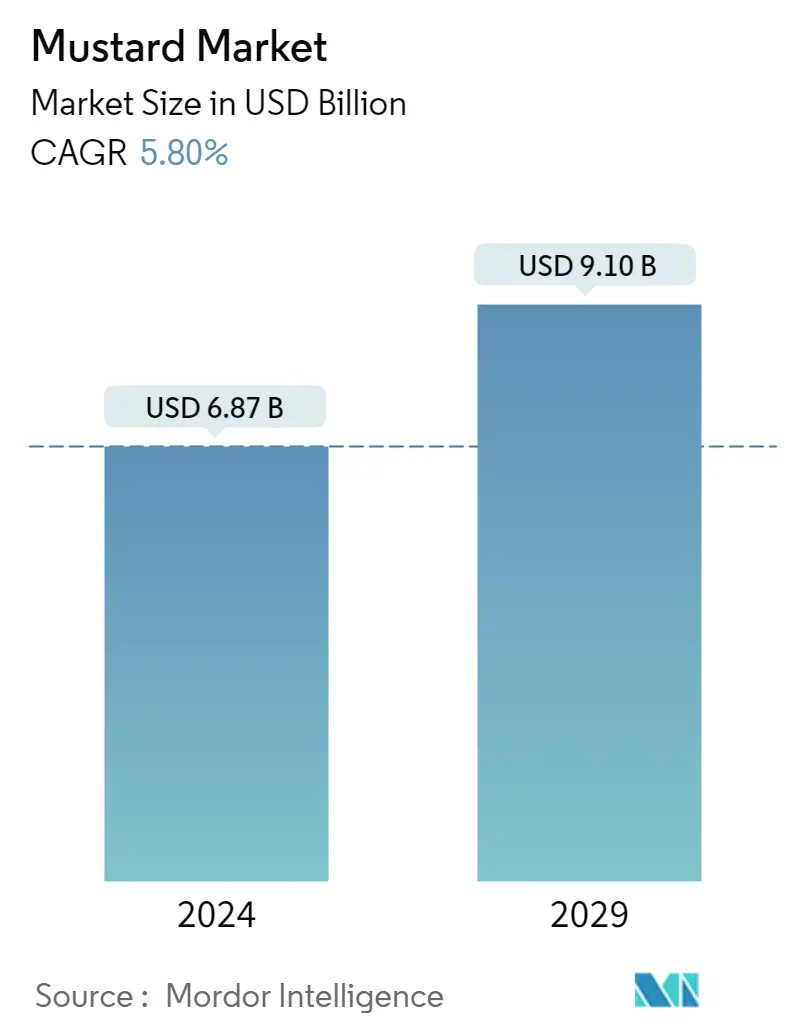Market Size of Mustard Industry

| Study Period | 2019 - 2029 |
| Market Size (2024) | USD 6.87 Billion |
| Market Size (2029) | USD 9.10 Billion |
| CAGR (2024 - 2029) | 5.80 % |
| Fastest Growing Market | Asia Pacific |
| Largest Market | Africa |
Major Players
*Disclaimer: Major Players sorted in no particular order |
Mustard Market Analysis
The Mustard Market size is estimated at USD 6.87 billion in 2024, and is expected to reach USD 9.10 billion by 2029, growing at a CAGR of 5.80% during the forecast period (2024-2029).
According to data provided by National Commodity & Derivatives Exchange Limited, it is a significant oilseed crop that produces roughly 14% of the world's vegetable oil production. After palm and soybean oil, mustard is among the top three vegetable oil sources (NCDEX). India is the leading producer of mustard in Asia, and mustard oil is the principal cooking oil in Indian cuisine. At the same time, the uses for the defatted mustard cake include animal feed and fertilizer. The market is projected to be significantly increasing for mustard oil in the upcoming years because mustard seeds are increasingly used in food and beverage, pharmaceutical, personal care, cosmetic, and other industries.
Mustard seed is another excellent source of protein. This crop's seed is also high in fiber, erucic acid, palmitic acid, tocopherols, tocotrienols, carotene, oryzanol, squalene, and thiamine, among other minerals, vitamins, antioxidants, and phytonutrients.
COVID-19 had a significant effect on the market. This was due to the health benefits that the mustard carries with it, such as blocking microbial growth, promoting skin health, reduces inflammation. The consumer's consciousness towards the health benefits has tremendously dragged the per capita spending towards the mustard market. McCormick & Company, which is one the major players in the industry, has estimated growth of 26% in sales of french's mustard during fiscal 2021.
Currently, scientists are looking for nitrate-free alternatives to preserve meat products. The shelf life of meatballs can be increased by mixing ground mustard into the mixture. White mustard-based products received a better sensory review than controls or those made with black and brown mustard. The inclusion of mustard efficiently stops microbial growth in the final product. Therefore, mustard has vast application opportunities.
Mustard Industry Segmentation
Mustard seeds are the tiny round seeds of various mustard plants. The seeds are usually about 1 to 2 millimeters in diameter and may be colored from yellowish-white to black. The global mustard market has been segmented by distribution channel into online Retailing, hypermarkets/ supermarkets, convenience stores/ grocery stores, and other Retailing. The market is also segmented by geography, including countries in North America, Europe, Asia-Pacific, South America, the Middle East, and Africa. For each segment, the market sizing and forecasts have been done based on the value (in USD million).
| Form | |
| Seed | |
| Powder | |
| Oil | |
| Paste |
| Distribution Channel | |
| Online Retailing | |
| Hypermarkets/ Supermarkets | |
| Convenience Store/Grocery Stores | |
| Other Distribution Channels |
| Geography | |||||||||
| |||||||||
| |||||||||
| |||||||||
| |||||||||
|
Mustard Market Size Summary
The mustard market is poised for significant growth, driven by its status as a major oilseed crop and its diverse applications across various industries. As one of the top three sources of vegetable oil globally, mustard plays a crucial role in the culinary traditions of countries like India, where mustard oil is a staple cooking ingredient. The market is experiencing increased demand due to the health benefits associated with mustard seeds, which are rich in protein, fiber, and essential nutrients. This has led to a rise in per capita spending on mustard products, as consumers become more health-conscious. The versatility of mustard extends beyond culinary uses, with applications in pharmaceuticals, personal care, and cosmetics, further propelling market expansion. The COVID-19 pandemic has also highlighted the health benefits of mustard, contributing to its growing popularity.
The Asia-Pacific region, particularly India and China, is witnessing rapid growth in the mustard market, fueled by rising consumer demand and awareness of its health benefits. In India, mustard oil is extensively used in cooking, while in China, mustard leaves are a popular culinary ingredient. The competitive landscape of the mustard market is characterized by the presence of both domestic and international players, with companies like McCormick & Co., Unilever, and Conagra Brands Inc. leading the charge. These companies are actively engaging in product innovation and strategic mergers and acquisitions to maintain their market dominance. Recent developments, such as Emami Agrotech's investment in mustard oil and Pansari Group's relaunch of its Oreal edible oil range, underscore the dynamic nature of the market. The growing trend towards organic and health-focused products, such as ORAH Extra Virgin Mustard Oil, is expected to further drive market growth in the coming years.
Mustard Market Size - Table of Contents
-
1. MARKET DYNAMICS
-
1.1 Market Drivers
-
1.2 Market Restraints
-
1.3 Porter's Five Forces Analysis
-
1.3.1 Threat of New Entrants
-
1.3.2 Bargaining Power of Buyers/Consumers
-
1.3.3 Bargaining Power of Suppliers
-
1.3.4 Threat of Substitute Products
-
1.3.5 Intensity of Competitive Rivalry
-
-
-
2. MARKET SEGMENTATION
-
2.1 Form
-
2.1.1 Seed
-
2.1.2 Powder
-
2.1.3 Oil
-
2.1.4 Paste
-
-
2.2 Distribution Channel
-
2.2.1 Online Retailing
-
2.2.2 Hypermarkets/ Supermarkets
-
2.2.3 Convenience Store/Grocery Stores
-
2.2.4 Other Distribution Channels
-
-
2.3 Geography
-
2.3.1 North America
-
2.3.1.1 United States
-
2.3.1.2 Canada
-
2.3.1.3 Mexico
-
2.3.1.4 Rest of North America
-
-
2.3.2 Europe
-
2.3.2.1 Spain
-
2.3.2.2 United Kingdom
-
2.3.2.3 Germany
-
2.3.2.4 France
-
2.3.2.5 Italy
-
2.3.2.6 Russia
-
2.3.2.7 Rest of Europe
-
-
2.3.3 Asia Pacific
-
2.3.3.1 China
-
2.3.3.2 Japan
-
2.3.3.3 India
-
2.3.3.4 Australia
-
2.3.3.5 Rest of Asia-Pacific
-
-
2.3.4 South America
-
2.3.4.1 Brazil
-
2.3.4.2 Argentina
-
2.3.4.3 Rest of South America
-
-
2.3.5 Middle East and Africa
-
2.3.5.1 South Africa
-
2.3.5.2 United Arab Emirates
-
2.3.5.3 Rest of Middle East and Africa
-
-
-
Mustard Market Size FAQs
How big is the Mustard Market?
The Mustard Market size is expected to reach USD 6.87 billion in 2024 and grow at a CAGR of 5.80% to reach USD 9.10 billion by 2029.
What is the current Mustard Market size?
In 2024, the Mustard Market size is expected to reach USD 6.87 billion.

